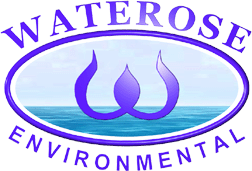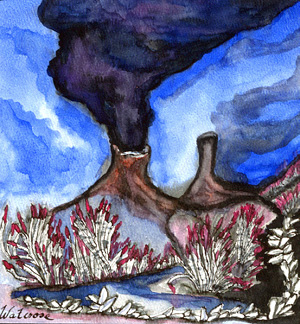 | ||||||
| Articles | Projects | Resume | Cartoons | Windsurfing | Paintings | Album |
Microbes in the Marine Environment


Bacteria are ubiquitous; they are found in every habitat on Earth, and some would say, even on Mars. The oldest forms of bacteria are prokaryotes from the Kingdom Monera. These originated approximately three and a half billion years ago in an anaerobic high radiation environment (Campbell, 1993). Prokaryotes are divided into two groups: the Archaebacteria, the oldest anaerobic group that is found in extreme environments, and the Eubacteria, a more modern group found in both anaerobic and aerobic environments. Bacteria changed the chemical composition of the ecosphere and are found in every niche in the marine environment.
Organisation of the Ecosystem:
The marine environment is characterized by saline water (Atlas, 1998). The ocean is rich in water soluble minerals including larger amounts of sodium, chlorine, magnesium, sulfate, calcium, potassium; and, lesser amounts of nitrogen, phosphorous and iron. The coastal areas provide a wide diversity of ecological niches where fresh water and saline water converge in estuaries; however, the ocean is fairly uniform due to mechanical mixing mechanisms. Ocean saline concentrations average 3.5 parts per thousand whereas estuary saline concentrations range between 5 and 25 parts per thousand creating a wide range of ecosystem environments.The marine environment is stratified vertically and horizontally; the key factors that change are light penetration, temperature, nutrients and oxygen content. The horizontal zones that extend from the shore are the littoral or intertidal zone, the sublittoral or neritic zone, and the pelagic or open water zone. The pleuston is the tension layer at the water and air interface. The water column is stratified by light penetration; photosynthesis occurs in the upper euphotic water layer, to a depth of 25 metres from the surface, and below is the disphotic or aphotic zone. The vertical regions that extend downward from the intertidal zone are the benthic region, the continental slope or bathyl region, the deep-sea floor or abyssal plain, and the deep ocean trenches or hadal region. Each zone or region has different characteristics; photon penetration, available nutrients, oxygen content and temperature differentials create specific microbial niches.
Advantages and Limitations to Microbial Growth:
The estuarine environment is unique for microbes because of the constantly changing environmental parameters that create a wide diversity of ecological niches (Atlas, 1998). Estuaries have high nutrients and high photon energy; consequently, they are the most productive marine ecosystem for photosynthetic aerobes. The range of saline concentrations creates three types of niches: fresh water, brackish water, and saline water. Each niche is occupied by organisms that are adapted for those conditions. This form of ecological partitioning reduces exploitative competition and enhances growth of different types of microbial communities (Campbell, 1993). Similarly, the continental shelf and the coral reefs are areas of high productivity due to high nutrients and photon energy, but without the extreme salinity gradient (Atlas, 1998).Conversely, the ocean zones are not as highly productive except for the pleuston layer where there is adequate light for bacteria that are primary producers. The pelagic offshore zone does not have enough nutrients at the surface to support significant microbial growth. The primary producers lyse and sink to the deep benthic zone. The benthic zone, rich in nutrients, does not have enough light energy to support primary productivity.
Other forms of energy deep in the hadal trenches, combined with fresh outpourings of chemical nutrients from the molten core, provide the environmental conditions for islands of deep undersea communities of rare bacteria and invertebrate species (Geographic, 1979). The deep sea vents occur on the ocean floor where the ocean crustal plates spread apart, and cause plumes of hot lava to erupt into the ocean. The high concentrations of electron rich elemental compounds and the thermal heat from the lava vents create an extreme environment that is most akin to primordial earth conditions. This is the realm of the anaerobes such as methanogenic Archaebacteria, and aphotic eubacteria such as the chemoautotrophs (Campbell, 1993). Each type of bacteria has special adaptations that enable the organism to obtain metabolic energy, and to withstand the extreme environmental conditions of high pressure and temperatures over one hundred degrees Celsius.
ADDENDUM NOTE 2001:
Some comments regarding the thermal process for producing phosphorous from phosphate rock from Jim and Liz Rock in Texas reproduced with permission:
"In some texts, the primary reaction of Calcium phosphate plus silica yields P4 plus Calcium silicate. In other discussions of phosphate rock, the primary natural form of phosphate is fluorapatite Ca5(Po4)3 F.
The question is:
What happens to the Fluoride during the thermal process? It is released as Ca F2, or in some other form?
There are reports from the US NIEHS claiming Fluoride contamination in Florida soils on the site of an old thermal phosphate plant in Tarpon Springs Florida."
Jim did some further research and graciously provided this additional information.
The Fl reacts with Si and with H to form Si-F4 and H-F. The proportion depends to some extent on the quantity of excess water in the water scrubber downstream from the furnace. Both dissolve in water to form their respective acids. Si-F4, H-F and C-0 are the serious acute health hazards associated with the electrothermal process for producing phosphorous from phosphate rocks. Additionally, the safety hazard arises because P4, the so-called white (or yellow) allotrope of phosphorous burns on contact with air (or with a person's skin).
References:
Gerhard A. Cook, "Survey of Modern Industrial Chemistry," 1975, Ann Arbor Science, Ann Arbor MI,ISBN 0-250-40106-1
M.B. Hocking, "Modern Chemical Technology and Emission Control," 1984, Springer Verlag, NY. ISBN 0-387-13466-2 (He was with Dept of Chem, Univ of Victoria, BC)
M.B. Hocking, "Handbook of Chemical Technology and Pollution Control," 1993, Academic Press, NY ISBN 0-12-350810-X (He was with Dept of Chem, Univ of Victoria, BC)"
Thank you Jim, for making the time to send this onto us.
Microbes Present:
The archaebacteria have unique characteristics that distinguish them from eubacteria. For example, the cell walls of the archaebacteria do not contain peptidoglycan, and the plasma membranes have a unique lipid composition (Campbell, 1993). Two abundant species include Thermococcus and Pyrodictium (Atlas,1998). The Beggiatoa and Thiomicrospira are major oxidisers that reduce sulphur from the vents. The Methanococcus use hydrogen to reduce carbon dioxide to methane (Campbell, 1993). The bacteria provide the organic nutrients for the development of communities of invertebrates including tube worms, clams, mussels and crabs (Geographic, 1979). The combination of bacteria, sulphur and heat produces a milky blue shimmer around the vent opening.Moving away from the deep sea vents the concentration of microbial populations drops dramatically (Atlas, 1998). There are heterotrophic bacteria in the sea floor sediments that feed upon photoautotrophic cyanobacteria that drift down attached to sediment particles. Moving upwards from the floor, the concentration of bacteria increases in the eutrophic levels.
The pleuston is a highly productive layer that is home to bacteria, algae, fungi, and protozoa. Dominant bacteria include Pseudomonas, Erythrobacter, Erythromicrobium, Protaminobacter, and Roseobacter. Other organisms include the cyanobacteria, diatoms, and phaeophyta.
The most notable feature about the microbes in the marine environment is the wide diversity due to the partitioning of the environment. Organisms adapt to their ecological niche. The marine environment includes the oldest known bacteria, the archaebacteria that are the strictest anaerobes (Campbell, 1993). The archaebacteria evolved into the eubacteria and possibly the eukaryotes.
The study of marine microbes in modern ecosystems and in hostile environments is a valuable science to understanding where we came from, and possibly, where we are going.
References:
Written for Royal Roads University ES317 Microbiology and Biochemistry Lecture SeriesAtlas, R. 1998. Microbial Ecology: Fundamentals and Applications. Benjamin Cummings. Menlo Park, Ca. 694 pp.
Campbell, N. 1993. Biology. Third Edition. Benjamin Cummings. Redwood City,Ca. 1190 pp.
National Geographic. 1979. “Strange World without Sun." Vol.156, No. 5. pp. 680-705.
Return to Index of Articles

 email Waterose
email Waterose
Please Sign My Guestbook
Please View My Guestbook

| Articles | Projects | Resume | Cartoons | Windsurfing | Paintings | Album |
 | ||||||